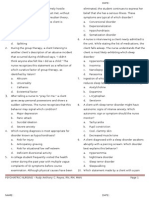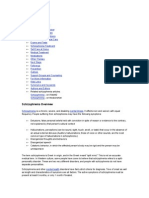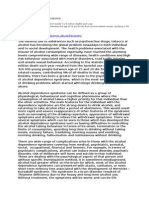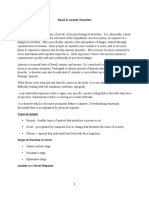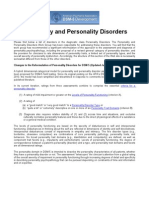100%(2)100% found this document useful (2 votes)
506 viewsChapter 14 Anxiety and Anxiety Disorders
Chapter 14 Anxiety and Anxiety Disorders
Uploaded by
Catia FernandesThis document discusses anxiety and anxiety disorders. It defines key terms and describes anxiety as a response to stress in three stages: alarm, resistance, and exhaustion. It also discusses the levels of anxiety from mild to panic and how they impact behavior. Defense mechanisms are explained as unconscious cognitive distortions used to reduce anxiety that can inhibit growth. Theories on the etiology of anxiety disorders include genetic, neurochemical, psychodynamic, interpersonal, and behavioral factors. Treatments discussed include medications and cognitive-behavioral therapies.
Copyright:
© All Rights Reserved
Available Formats
Download as DOCX, PDF, TXT or read online from Scribd
Chapter 14 Anxiety and Anxiety Disorders
Chapter 14 Anxiety and Anxiety Disorders
Uploaded by
Catia Fernandes100%(2)100% found this document useful (2 votes)
506 views4 pagesThis document discusses anxiety and anxiety disorders. It defines key terms and describes anxiety as a response to stress in three stages: alarm, resistance, and exhaustion. It also discusses the levels of anxiety from mild to panic and how they impact behavior. Defense mechanisms are explained as unconscious cognitive distortions used to reduce anxiety that can inhibit growth. Theories on the etiology of anxiety disorders include genetic, neurochemical, psychodynamic, interpersonal, and behavioral factors. Treatments discussed include medications and cognitive-behavioral therapies.
Original Description:
Psychiatric/Mental Health Nursing
Copyright
© © All Rights Reserved
Available Formats
DOCX, PDF, TXT or read online from Scribd
Share this document
Did you find this document useful?
Is this content inappropriate?
This document discusses anxiety and anxiety disorders. It defines key terms and describes anxiety as a response to stress in three stages: alarm, resistance, and exhaustion. It also discusses the levels of anxiety from mild to panic and how they impact behavior. Defense mechanisms are explained as unconscious cognitive distortions used to reduce anxiety that can inhibit growth. Theories on the etiology of anxiety disorders include genetic, neurochemical, psychodynamic, interpersonal, and behavioral factors. Treatments discussed include medications and cognitive-behavioral therapies.
Copyright:
© All Rights Reserved
Available Formats
Download as DOCX, PDF, TXT or read online from Scribd
Download as docx, pdf, or txt
100%(2)100% found this document useful (2 votes)
506 views4 pagesChapter 14 Anxiety and Anxiety Disorders
Chapter 14 Anxiety and Anxiety Disorders
Uploaded by
Catia FernandesThis document discusses anxiety and anxiety disorders. It defines key terms and describes anxiety as a response to stress in three stages: alarm, resistance, and exhaustion. It also discusses the levels of anxiety from mild to panic and how they impact behavior. Defense mechanisms are explained as unconscious cognitive distortions used to reduce anxiety that can inhibit growth. Theories on the etiology of anxiety disorders include genetic, neurochemical, psychodynamic, interpersonal, and behavioral factors. Treatments discussed include medications and cognitive-behavioral therapies.
Copyright:
© All Rights Reserved
Available Formats
Download as DOCX, PDF, TXT or read online from Scribd
Download as docx, pdf, or txt
You are on page 1of 4
1
Chapter 14: Anxiety & Anxiety Disorders
Key terms:
Agoraphobia: fear of being outside
Anxiety: a vague feeling of dread or apprehension; it is a response to external or internal stimuli that
can have behavioral, emotional, cognitive, and physical symptoms
Anxiety disorders: Group of conditions that share a key feature of excessive anxiety, with ensuing
behavioral, emotional, cognitive, physiologic changes
Assertiveness training: the Ability to express positive and negative ideas and feelings in an open,
honest, and direct way
Avoidance behavior: behaviors designed to avoid unpleasant consequences or potentially threatening
situations
Decatastrophizing: a technique that involves learning to assess situations realistically rather than
always assuming catastrophe will happen
Defense mechanisms: cognitive distortions that a person uses unconsciously to maintain a sense of
being in control of the situation, to lessen discomfort, and to deal with stress; also called ego defense
mechanisms
Depersonalization: feelings of being disconnected from himself or herself; the client feels detached
from his or her behavior
Derealization: client senses that events are not real, when, in fact, they are
Fear: feeling afraid or threatened by a clearly identifiable, external stimulus that represents danger to
the person
Flooding: a form of rapid desensitization in which a behavioral therapist confronted the client with the
focus object (either a picture of the actual object) until it no longer produces the anxiety
Mild anxiety: a sensation that something is different and warrants special attention
Moderate anxiety: the disturbing feeling that something is definitely wrong; the person becomes
nervous or agitated
Panic anxiety: intense anxiety, may be a response to a life-threatening situation
Panic attacks: between 15 and 30 minutes of rapid, intense, escalating anxiety in which the person
experiences great emotional fear as well as physiologic discomfort
Panic disorder: composed of discrete episodes of panic attacks, that is, 15-30 minutes of rapid, intense,
escalating anxiety in which the person experiences great emotional fear as well as physiologic
discomfort
Phobia: an illogical, intense, and persistent fear of a specific object or social situation that causes
extreme distress and interferes with normal functioning
Positive reframing: a cognitive-behavioral technique involving turning negative messages into positive
ones
Primary gain: the relief of anxiety achieved by performing the specific anxiety-driven behavior; the
direct external benefits that being sick provides, such as relief of anxiety, conflict, or distress
Secondary gain: the internal or personal benefits received from others because one is sick, such as
attention from family members, comfort measures, and being excused from usual responsibilities or
tasks
Selective mutism:
Severe anxiety: an increased level of anxiety when more primitive survival skills take over, defensive
responses ensure, and cognitive skills decreased significantly; person with severe anxiety has trouble
thinking and reasoning
Stress: the wear and tear that life causes on the body
2
Chapter 14: Anxiety & Anxiety Disorders
Systematic desensitization: behavioral technique used to help overcome irrational fears and anxiety
associated with a phobia
Learning Objectives:
1. Describe anxiety as a response to stress.
a. Alarm stage: stress stimulates the body to send messages from the hypothalamus to the glands
and organs to prepare for potential defense needs
b. Resistance stage: the digestive system reduces function to shunt blood to areas needed for
defense. The lungs take in more air, the heart beats faster and harder so it can circulate this
highly oxygenated and highly nourished blood to the muscles to defend the body by fight,
flight, or freeze behaviors.
c. Exhaustion stage: occurs when the person has responded negatively to anxiety and stress: body
stores are depleted, or the emotional components are not resolved, resulting in continual
arousal of the physiologic responses and little reserve capacity.
2. Describe the levels of anxiety with behavioral changes related to each level.
a. Mild: sensory stimulation increases and helps the person focus attention to learn, solve
problems, think, act, feel, and protect himself or herself. It motivates people to make changes
or to engage in goal-directed anxiety.
b. Moderate: In moderate anxiety, the person can still process information, solve problems, and
learn new things with assistance from others. He or she has difficulty concentrating
independently but can be redirected to the topic.
c. Severe: Trouble thinking and reasoning; muscles tighten and vital signs increase; the person
paces, is restless, irritable, and angry; or uses other similar emotion-psychomotor means to
release tension.
d. Panic: the emotional=psychomotor realm predominates with accompanying fight, flight, or
freeze responses. Adrenaline surge greatly increases vital signs. Pupils enlarge to let in more
light, and the only cognitive process focuses on the persons defense.
3. Discuss the use of defense mechanisms by people with anxiety disorders.
a. Freud described defense mechanisms as the human's attempt to control awareness of and to
reduce anxiety. Defense mechanisms are cognitive distortions that a person uses unconsciously
to maintain a sense of being in control of a situation, to lessen discomfort, and to deal with
stress. Because defense mechanisms arise from the unconscious, the person is unaware of
using them. Some people overuse defense mechanisms, which stops them from learning a
variety of appropriate methods to resolve anxiety-producing situations. The dependence on
one or two defense mechanisms also can inhibit emotional growth, lead to poor problem-
solving skills, and create difficulty with relationships.
b. Defense mechanisms can help a person to reduce anxiety. This is the only positive outcome of
using defense mechanisms. The dependence on defense mechanisms can inhibit emotional
growth, lead to poor problem-solving skills, and create difficulty with relationships. These are
all negative outcomes of using defense mechanisms.
3
Chapter 14: Anxiety & Anxiety Disorders
4. Describe the current theories regarding the etiologies of major anxiety disorders.
a. Biologic Theories
i. Genetic theories
1. Anxiety may have an inherited component because first-degree relatives of
clients with increased anxiety have higher rates of developing anxiety
ii. Neurochemical theories
1. Gamma-aminobutyric acid (GABA) is the amino acid neurotransmitter believed
to be dysfunctional in anxiety disorders. GABA reduces anxiety, and
norepinephrine increases it; researchers believe that a problem with the
regulation of these neurotransmitters occurs in anxiety disordersPsychodynamic
Theories
iii. Intrapsychic/Psychoanalytic Theories
1. Freud's intrapsychic theory views a person's innate anxiety as the stimulus for
behavior.
iv. Interpersonal theory
1. Interpersonal theories include Sullivan's theory that anxiety is generated from
problems in interpersonal relationships and Peplau's belief that humans exist in
interpersonal and physiologic realms.
v. Behavioral theory
1. Behavioral theorists view anxiety as being learned through experiences.
5. Evaluate the effectiveness of treatment including medications for clients with anxiety disorders.
a. Anxiolytics are designed for short-term use to relieve anxiety. These drugs are designed to
relieve anxiety so that the person can deal more effectively with whatever crisis or situation is
causing stress. Benzodiazepines tend to cause dependence. Clients need to know that
antianxiety agents are aimed at relieving symptoms such as anxiety but do not treat the
underlying problems that cause the anxiety. See Table 14.2 Anxiolytics Drugs
6. Apply the nursing process to the care of clients with anxiety and anxiety disorders.
a. Assessment
i. History: clients seeks treatment for panic disorder after theyve experienced several
panic attacks. Usually, they cant identify any trigger for these events
ii. General Appearance and Motor Behavior: client may appear normal or may have signs
of anxiety if they are apprehensive about having a panic attack in the next few
moments. If they are anxious, speech may increase in rate, pitch, and volume, and they
may have difficulty sitting in a chair. Automatisms may be apparent, such as tapping
fingers, jingling keys, or twisting hair. Automatisms are geared toward anxiety relief and
increase in frequency and intensity with the clients anxiety level.
iii. Mood and Affect: may reveal that the client is anxious, worried, tense, depressed,
serious, or sad. May be tearful, angry.
iv. Thought processes and content: during a panic attack, the client is overwhelmed,
believing they are dying, losing control, or going insane.
v. Sensorium and intellectual processes: the client may become confused and disoriented.
They cannot take in environmental cues and respond appropriately.
vi. Judgment and insight: judgment is suspended during panic attacks. Insight into panic
disorder occurs only after the client has been educated about the disorder.
vii. Self-concept: Nurse must assess self-concept in clients with panic disorder.
viii. Roles and relationships: Client may report alterations in his or her social, occupational,
or family life. Avoiding these objects does not stop the panic attacks, but the persons
4
Chapter 14: Anxiety & Anxiety Disorders
sense of helplessness is so great that he or she may take even more restrictive measures
to avoid them.
ix. Physiologic and self-care concerns: reports of problems sleeping and eating; they may
eat constantly or experience loss of appetite in an attempt to ease the anxiety
b. Data analysis
i. Common diagnoses
1. Risk for injury
2. Anxiety
3. Situational low self-esteem (panic attacks)
4. Ineffective coping
5. Powerlessness
6. Ineffective role performance
7. Disturbed sleep pattern
c. Intervention
i. Provide a safe environment and ensure the clients privacy during a panic attack
ii. Remain with the client during a panic attack
iii. Help the client to focus on deep breathing
iv. Talk to the client in a calm, reassuring voice
v. Teach the client to use relaxation techniques
1. The nurse can teach the client relaxation techniques to use when he or she is
experiencing stress or anxiety, including deep breathing, guided imagery and
progressive relaxation, and cognitive restructuring techniques. For any of these
techniques, it is important for the client to learn and to practice them when he
or she is relatively calm.
vi. Help the client to use cognitive restructuring techniques
vii. Engage the client to explore how to decrease stressors and anxiety-provoking situations
7. Provide teaching to clients, families, caregivers, and communities to increase understanding of
anxiety and stress-related disorders.
a. Client/family education for panic disorder includes reviewing breathing control and relaxation
techniques, discussing positive coping strategies, encouraging regular exercise, emphasizing the
importance of maintaining prescribed medication regimen and regular follow-up, describing
time management techniques such as creating to do lists with realistic estimated deadlines
for each activity, crossing off completed items for a sense of accomplishment, saying no, and
stressing the importance of maintaining contact with community and participating in
supportive organizations. Medication should be adhered to as prescribed. Daily responsibilities
cannot be avoided, rather should be successfully accomplished.
8. Examine your feelings, beliefs, and attitudes regarding clients with anxiety disorders.
a. Nurses must understand why and how anxiety behaviors work, not just for client care but to
help understand the role anxiety plays in performing nursing responsibilities. Nurses are
expected to function at a high level and to avoid allowing their own feelings and needs to
hinder the care of their clients, but as emotional beings, nurses are just as vulnerable to stress
and anxiety as others, and they have needs of their own.
You might also like
- PMH Nursing Care Plan 01112017Document19 pagesPMH Nursing Care Plan 01112017api-371817203No ratings yet
- Chapter 18 Personality DisordersDocument10 pagesChapter 18 Personality DisordersCatia Fernandes100% (2)
- Chapter 18 Personality DisordersDocument10 pagesChapter 18 Personality DisordersCatia Fernandes100% (2)
- Chapter 19 Substance AbuseDocument8 pagesChapter 19 Substance AbuseCatia Fernandes100% (1)
- Nursing Care Plan For A Patient With Bipolar DisorderDocument20 pagesNursing Care Plan For A Patient With Bipolar Disordermjk2100% (4)
- Chapter 12 Abuse and ViolenceDocument5 pagesChapter 12 Abuse and ViolenceCatia FernandesNo ratings yet
- Week 5 Inp Psychiatric Nursing (Schizophrenia)Document15 pagesWeek 5 Inp Psychiatric Nursing (Schizophrenia)Michelle Gliselle Guinto MallareNo ratings yet
- Chapter 11 Anger, Hostility, and AggressionDocument4 pagesChapter 11 Anger, Hostility, and AggressionCatia Fernandes100% (1)
- Chapter 12 - Grief and LossDocument7 pagesChapter 12 - Grief and LossMonicaNo ratings yet
- Psychiatric NursingDocument25 pagesPsychiatric NursingFerreze AnnNo ratings yet
- Nursing Care and Management of Client With SchizophreniaDocument29 pagesNursing Care and Management of Client With SchizophreniaMaizatul Akmar IbrahimNo ratings yet
- Chapter 24 Cognitive DisordersDocument7 pagesChapter 24 Cognitive DisordersCatia Fernandes100% (1)
- Chapter 11 Anger, Hostility, and AggressionDocument4 pagesChapter 11 Anger, Hostility, and AggressionCatia Fernandes100% (1)
- CH 22 Neurodevelopmental DisordersDocument7 pagesCH 22 Neurodevelopmental DisordersCatia Fernandes100% (1)
- Chapter 2 - Neurobiologic Theories and PsychopharmacologyDocument11 pagesChapter 2 - Neurobiologic Theories and PsychopharmacologyCatia FernandesNo ratings yet
- Chapter 12 Abuse and ViolenceDocument5 pagesChapter 12 Abuse and ViolenceCatia FernandesNo ratings yet
- Chapter 4 Treatment Settings and Theraputic PRogramsDocument5 pagesChapter 4 Treatment Settings and Theraputic PRogramsCatia Fernandes100% (1)
- What Is Organizational Behavior?: Presented By: Nur Hasanah, Se, MSCDocument42 pagesWhat Is Organizational Behavior?: Presented By: Nur Hasanah, Se, MSCAyu WidiaNo ratings yet
- OCD and Related DisordersDocument40 pagesOCD and Related Disorderscatherine faith gallemitNo ratings yet
- Psychiatric NursingDocument93 pagesPsychiatric Nursingjunie100% (5)
- Maladaptive Patterns of Behavior A. AnxietyDocument19 pagesMaladaptive Patterns of Behavior A. AnxietyTeal Otter100% (1)
- Basic Principles of Psychiatric NursingDocument5 pagesBasic Principles of Psychiatric NursingJo C Cuilan100% (1)
- Chapter 3 Psychosocial Theories and TherapyDocument10 pagesChapter 3 Psychosocial Theories and TherapyCatia FernandesNo ratings yet
- Chapter 19 - AddictionDocument5 pagesChapter 19 - AddictiondabenNo ratings yet
- Chapter 17 Mood Disorders and SuicideDocument6 pagesChapter 17 Mood Disorders and SuicideCatia Fernandes100% (2)
- Psychiatric Nursing2 Questions)Document6 pagesPsychiatric Nursing2 Questions)Pamela MagsajoNo ratings yet
- Psych Practice 1 QuestionDocument8 pagesPsych Practice 1 QuestionAngela Eun AnNo ratings yet
- Anxiety DisordersDocument8 pagesAnxiety DisordersSydney DeringNo ratings yet
- Psychiatric NursingDocument20 pagesPsychiatric NursingRI NA100% (1)
- Psych Typical Manif 1Document10 pagesPsych Typical Manif 1Arfi FachrulNo ratings yet
- Chapter 23 Disruptive Beahvior DisordersDocument5 pagesChapter 23 Disruptive Beahvior DisordersCatia Fernandes100% (1)
- Schizophrenia OverviewDocument8 pagesSchizophrenia OverviewRiscky LauwNo ratings yet
- Schizophrenia: Signs and SymptomsDocument38 pagesSchizophrenia: Signs and SymptomsRatu Nurul Fadhilah100% (1)
- Videbeck Chapter 8 Assessment - NO NOTESDocument22 pagesVidebeck Chapter 8 Assessment - NO NOTESKatie McFarlandNo ratings yet
- SchizophreniaDocument3 pagesSchizophreniaPete Cobra Cobraiti100% (2)
- Drug Study of SchizophreniaDocument17 pagesDrug Study of SchizophreniaCLOYD MARVINNo ratings yet
- Nursing Precautions For Suicidal PatientDocument6 pagesNursing Precautions For Suicidal PatientSimran JosanNo ratings yet
- Chapter 6 Therapeutic CommunicationDocument2 pagesChapter 6 Therapeutic CommunicationCatia Fernandes100% (1)
- Risk For ViolenceDocument5 pagesRisk For Violencemikaela_pascuaNo ratings yet
- Post Test NUR 219 17Document3 pagesPost Test NUR 219 17Naomi VirtudazoNo ratings yet
- NCP SchizophreniaDocument7 pagesNCP SchizophreniaSteffi Raye Madrid50% (2)
- CHAPTER 16 - Schizophrenia 2Document15 pagesCHAPTER 16 - Schizophrenia 2Rebecca100% (1)
- Chapter 13 Trauma and Stress-Related DisordersDocument7 pagesChapter 13 Trauma and Stress-Related DisordersCatia FernandesNo ratings yet
- Case Study SchizophreniaDocument3 pagesCase Study SchizophreniaCHRISANTO ARZANANNo ratings yet
- Chapter 16 SchizophreniaDocument9 pagesChapter 16 SchizophreniaCatia FernandesNo ratings yet
- Nursing Process in Psychiatric NursingDocument14 pagesNursing Process in Psychiatric NursingJomark Palgan100% (1)
- Psychiatric NurseslabsDocument28 pagesPsychiatric NurseslabsStephanie Villanueva AdvinculaNo ratings yet
- Psychiatric Nursing (Personality Disorders)Document9 pagesPsychiatric Nursing (Personality Disorders)Magbanua Airene MarielNo ratings yet
- Psychiatric NursingDocument32 pagesPsychiatric NursingPinky Cuaresma100% (1)
- Maladaptive Exam 1Document20 pagesMaladaptive Exam 1Wen SilverNo ratings yet
- Role - Responsibilities of Psychiatry Health NurseDocument3 pagesRole - Responsibilities of Psychiatry Health NurseDhAiRyA ArOrANo ratings yet
- Role Case StudyDocument7 pagesRole Case StudyKomal KhanNo ratings yet
- Obsessive Compulsive DisorderDocument14 pagesObsessive Compulsive Disorderfrancis00090100% (1)
- Lecture Notes For Mental Health Nursing Psych NursingDocument88 pagesLecture Notes For Mental Health Nursing Psych Nursingjg369097100% (1)
- Neurobiologic Theories and PsychopharmacologyDocument3 pagesNeurobiologic Theories and Psychopharmacologygeorgeloto12100% (1)
- Mood Disorders NotesDocument10 pagesMood Disorders NotesjisooNo ratings yet
- Alcohol Dependence SyndromeDocument3 pagesAlcohol Dependence SyndromeMohd AminuddinNo ratings yet
- 117 Quizzes Midterm FinalsDocument12 pages117 Quizzes Midterm FinalsJade CentinoNo ratings yet
- Paranoid SchizophreniaDocument26 pagesParanoid SchizophreniaCrisha Ann Billones BacutaNo ratings yet
- Nursing Psych Exam QuestionsDocument3 pagesNursing Psych Exam QuestionsLaurie RNtobeNo ratings yet
- The Ride of Your Life: What I Learned about God, Love, and Adventure by Teaching My Son to Ride a BikeFrom EverandThe Ride of Your Life: What I Learned about God, Love, and Adventure by Teaching My Son to Ride a BikeRating: 4.5 out of 5 stars4.5/5 (2)
- Anxiety DisordersDocument7 pagesAnxiety Disorderssuresh patilNo ratings yet
- Anxiety Chapter EditedDocument19 pagesAnxiety Chapter EditedamarnehNo ratings yet
- Anxiety - For StudentsDocument44 pagesAnxiety - For StudentsifyNo ratings yet
- AnxietyDocument8 pagesAnxietyhmwdynfzmsmdNo ratings yet
- Anxiety Disorders, Obsessive-Compulsive and Related DisordersDocument15 pagesAnxiety Disorders, Obsessive-Compulsive and Related DisordersdecusrnNo ratings yet
- Specific PhobiaDocument6 pagesSpecific Phobiacaly.032803No ratings yet
- Psych NotesDocument7 pagesPsych NotesLillabinNo ratings yet
- Chapter 23 Disruptive Beahvior DisordersDocument5 pagesChapter 23 Disruptive Beahvior DisordersCatia Fernandes100% (1)
- Chapter 20 Eating DisordersDocument5 pagesChapter 20 Eating DisordersCatia FernandesNo ratings yet
- Chapter 16 SchizophreniaDocument9 pagesChapter 16 SchizophreniaCatia FernandesNo ratings yet
- Chapter 21 Somatic Symptom IllnessesDocument5 pagesChapter 21 Somatic Symptom IllnessesCatia Fernandes100% (1)
- Chapter 13 Trauma and Stress-Related DisordersDocument7 pagesChapter 13 Trauma and Stress-Related DisordersCatia FernandesNo ratings yet
- Chapter 15 OCD and Related DisordersDocument4 pagesChapter 15 OCD and Related DisordersCatia FernandesNo ratings yet
- Chapter 9 Legal and Ethical IssuesDocument3 pagesChapter 9 Legal and Ethical IssuesCatia FernandesNo ratings yet
- Chapter 10 Grief and LossDocument6 pagesChapter 10 Grief and LossCatia Fernandes0% (1)
- Chapter 17 Mood Disorders and SuicideDocument6 pagesChapter 17 Mood Disorders and SuicideCatia Fernandes100% (2)
- Chapter 8 AssessmentDocument4 pagesChapter 8 AssessmentCatia FernandesNo ratings yet
- Chapter 6 Therapeutic CommunicationDocument2 pagesChapter 6 Therapeutic CommunicationCatia Fernandes100% (1)
- Chapter 5 Therapeutic RelationshipsDocument2 pagesChapter 5 Therapeutic RelationshipsCatia FernandesNo ratings yet
- Chapter 3 Psychosocial Theories and TherapyDocument10 pagesChapter 3 Psychosocial Theories and TherapyCatia FernandesNo ratings yet
- Chapter 7 Clients Response To IllnessDocument7 pagesChapter 7 Clients Response To IllnessCatia FernandesNo ratings yet
- Chapter 1 - Foundations of Psychiatric - Mental Health NursingDocument5 pagesChapter 1 - Foundations of Psychiatric - Mental Health NursingCatia Fernandes100% (2)
- Est 3Document92 pagesEst 3LegendNo ratings yet
- Scope of Nle821Document104 pagesScope of Nle821ericNo ratings yet
- Commun Cation SkillsDocument47 pagesCommun Cation SkillsJain SumeetNo ratings yet
- Eiattachment StylesDocument18 pagesEiattachment StylesRaluca CiufNo ratings yet
- Behavioural School of ThoughtDocument8 pagesBehavioural School of ThoughtKarthika DevanNo ratings yet
- APA - (2011) DSM-5 Development. Personality and Personality DisordersDocument16 pagesAPA - (2011) DSM-5 Development. Personality and Personality DisordersRodrigo Middleton InfanteNo ratings yet
- Bus714 Principles of Management SummaryDocument47 pagesBus714 Principles of Management SummaryNkiruka OkechkwuNo ratings yet
- LS Curriculum GuideDocument232 pagesLS Curriculum GuideWan Kin KwokNo ratings yet
- 3.2 Theories of Relationship SatisfactionDocument5 pages3.2 Theories of Relationship SatisfactionMuhammad Qasim AssadNo ratings yet
- 8 - Sullivan - Interpersonal TheoryDocument11 pages8 - Sullivan - Interpersonal TheoryAuie Trajano100% (1)
- Gladys 1982Document32 pagesGladys 1982Lucia PopaNo ratings yet
- Keys For Men - Myles MunroeDocument28 pagesKeys For Men - Myles Munroeobot samuel100% (1)
- Optional Public Administration 3 Theories of AdministrationDocument15 pagesOptional Public Administration 3 Theories of Administrationrajeshnaik_965429910No ratings yet
- Lesson 16 PDFDocument20 pagesLesson 16 PDFrajamsc2003No ratings yet
- Case Study JohnDocument8 pagesCase Study Johnapi-427522957No ratings yet
- The Concept of Work Life Balance EssayDocument10 pagesThe Concept of Work Life Balance EssaySoni Rathi100% (1)
- Snyder - VolunteerismDocument36 pagesSnyder - VolunteerismConti KucciNo ratings yet
- OB11 - 04in Personality and EmotionsDocument59 pagesOB11 - 04in Personality and EmotionsAjay Prakash VermaNo ratings yet
- Research HighlightsDocument25 pagesResearch HighlightsRoger BaliliNo ratings yet
- Process Consultation Revisited - My SummaryDocument32 pagesProcess Consultation Revisited - My Summaryapi-254207666No ratings yet
- OBB 1-1 Webster and Wind JM 1972Document9 pagesOBB 1-1 Webster and Wind JM 1972sajidoistNo ratings yet
- Life Skills Class VI PDFDocument274 pagesLife Skills Class VI PDFManish Makadia100% (2)
- InterpersonalDocument330 pagesInterpersonalPatricio FloresNo ratings yet
- Study Habits and Attitudes of Freshmen Students PDFDocument6 pagesStudy Habits and Attitudes of Freshmen Students PDFwillie2210No ratings yet
- Social Science BookDocument30 pagesSocial Science BookSushmaNo ratings yet
- Mental HealthDocument1 pageMental Healthpluk.shellacabrezosNo ratings yet
- Inteligencias MúltiplesDocument83 pagesInteligencias MúltiplesandresNo ratings yet
- Critique Paper On Social MediaDocument2 pagesCritique Paper On Social MediaAlex Mendoza100% (1)
- 32 586 4 PBDocument10 pages32 586 4 PBapi-274538823No ratings yet






















